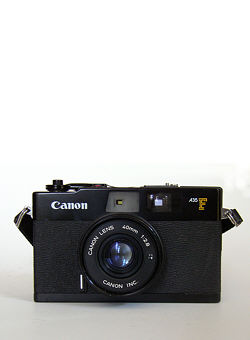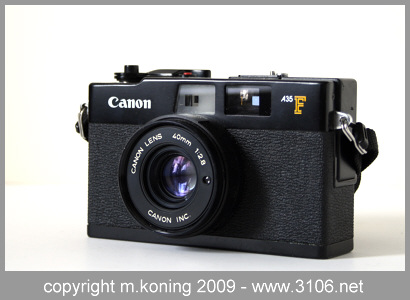3106.photography
Created 7 July 2007 ... Updated 7 July 2007
|
Canon A35F
|
||||||||||||||||||||||||||||||||||||||||||||||||||||||||||||||||||||||||||||
 This beautiful little rangefinder camera looks very modern, even though it appeared already in 1977. It was Canon's last of a series of metal rangefinders and offers such features as automatic exposure, built-in flash and parallax correction in a very small box. It's fairly heavy but also very sturdy for such a small camera and that's the way I like it, just fits better in my large hands. The camera had to compete with such cameras as the Konica C35 and Minolta Hi-Matic series. At the same time Canon released the first All Automatic and AutoFocus camera, the Canon AF35M (European name, the first "Sure Shot"), which is an entirely different camera altogether.
This beautiful little rangefinder camera looks very modern, even though it appeared already in 1977. It was Canon's last of a series of metal rangefinders and offers such features as automatic exposure, built-in flash and parallax correction in a very small box. It's fairly heavy but also very sturdy for such a small camera and that's the way I like it, just fits better in my large hands. The camera had to compete with such cameras as the Konica C35 and Minolta Hi-Matic series. At the same time Canon released the first All Automatic and AutoFocus camera, the Canon AF35M (European name, the first "Sure Shot"), which is an entirely different camera altogether.
Lens quality is said to be very good, lots of contrast and plenty sharp. I did not have time to try the camera myself yet but will soon. Camera reviews from 1978 tell us that the auto exposure is always spot-on. Whether the auto exposure is still correct today depends on your camera. The CdS cell could be slightly off and of course the 1,35 Volt mercury cells are not available anymore. But these could be replaced by hearing aid cells or replacement 1,5 Volt cells. Using the higher voltage batteries (1,5 Volt) seems only to have a theoretical effect on the exposure with this camera. According to a few sources, exposure is still correct, at least using negative film. I've not found any references to using slide film in this camera, so when you want to try, let me know what the results were. Since the auto exposure works very good the not implemented manual exposure is hardly ever missed. The exposure range of EV 9-17 (with ISO 100 film) is sufficient for the majority of light situations. Night time photography however is not possible since there is no Bulb setting and the maximum shutter speeds merely 1/60 second. The AE Lock feature is very useful under circumstances where the subject is either darker or brighter than average and works by pointing the camera at an averagely lighted subject, pressing the shutter button half way and pointing the camera towards the subject before releasing the shutter in order to take the picture. As with most range finders, the leaf shutter operates smoothly and quitly. The camera also does neither have a loud motordrive, no mirror nor any electronic beeping sounds so it could be used anywhere. The built in Flash could be enabled manually and contains a little intelligence, it checks the subject distance through the focus ring setting and sets the flash output accordingly. Canon named this system Canon Auto Tuning System (CAT System). Of course the flash being fairly small (guide number 12), you cannot expect wonders but it's apperently not too bad when you take some basic precautions such as minimum and maximum subject distances. This was Canons first camera with built-in flash. Another version of this camera is the Canon A35 Datelux, which is basically the same camera as the A35F but also had a date back for date imprinting. This feature was fairly new at the time but since then got added to many new cameras. Not sure if it's very useful, since I hat seeing a good picture spoiled by a large date somewhere in the corner but hey, it's apparently what many people wanted. Of course this feature has disappeared in the digital age, a much more sophisticated feature called EXIF Data has replaced the classic date back. Unfortunately the light seals of my camera were severely deteriorated, but this can easily be fixed. See the light trap repair guide on this website. Apart from that, the few I've seen still worked properly. They just seem to be built to last, one of the advantages of using a simple metal box to protect the delicate camera mechanism. Warning: When light falls on the CdS cell, the exposure metering system is active and slowly draining the battery. So it's advisable to either store the camera with the lens cap on the lens and/or in a dark place and/or with the batteries taken out. Latter is a good idea anyway, there are incountable cameras with dirty/destroyed battery compartments due to forgotten batteries that started leaking. Wll in all when you're looking for a great range finder camera don't look any further. The Canon A35F is perfect as a first range finder (before upgrading to a Leica...?) and it's a great, and very inexpensive camera to take with you, whereever you go. |
||||||||||||||||||||||||||||||||||||||||||||||||||||||||||||||||||||||||||||
Specifications
|
||||||||||||||||||||||||||||||||||||||||||||||||||||||||||||||||||||||||||||

|
||||||||||||||||||||||||||||||||||||||||||||||||||||||||||||||||||||||||||||
|
||||||||||||||||||||||||||||||||||||||||||||||||||||||||||||||||||||||||||||
All photos copyright of M. Koning 1997 - 2007
Note: Using the text or images on this site in an auction such as eBay without permission is a violation of your ebay Terms of Service. I will report you to ebay if I discover such a violation taking place. This may result in your account being cancelled. I also reserve the right to file claim for civil penalties.
Return